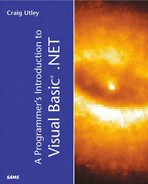The Start Page
The very first time you start Visual Studio .NET, you are taken to a screen that allows you to configure the IDE. That screen is the My Profile page discussed later in the chapter. After your first visit to the My Profile page, all subsequent starts of Visual Studio .NET begin with the Start Page, as shown in Figure 2.1. The start page contains a number of sections, as indicated by the links along the left side. These sections are
Get Started— This option allows you to open a recent or existing project, or create a new one. A few recent projects are listed on the Get Started area shown in Figure 2.1. As you create projects in VB .NET, this area will display the four most recently opened projects. This area also contains links to open an existing project, to create a new project, and to log a bug report. Expect this last option to disappear after the final product is released.
What's New— This option covers new language features in Visual Studio .NET, including each individual language and the Visual Studio .NET environment. There are links to topics in the help files on new features for the VS .NET languages, the .NET SDKs, and a link to check for VS .NET upgrades.
Online Community— This provides links to the Microsoft newsgroups. These are newsgroups accessible with any newsreader, but they are served from Microsoft's news server (msnews.microsoft.com) and not normal Usenet news servers.
Headlines— Provides a place for links to news about .NET. This page includes a link to MSDN Online, a section for technical articles, a section for the Knowledge Base, and a number of other resources.
Downloads— Gives you access to a number of downloads. Downloads can include new tools, such as service packs, the Mobile Internet Toolkit, and code samples. Downloads can also include code samples and new documentation.
Web Hosting— Allows you to connect directly to services that offer Web hosting for your .NET Web Services or .NET Web Applications. With one command, you can publish your .NET applications or services to these hosting companies. At least one, Brinkster, offers a free membership so that you can test your applications.
My Profile— This screen lets you choose the overall layout of Visual Studio .NET. You can set the keyboard mappings to the same scheme as in previous versions of Visual Studio, such as Visual Basic 6. You can also set the window layout to match previous versions of Visual Studio projects, and you can automatically filter help using the profile. Throughout this book, I will assume that the profile is set to Visual Studio Developer, and that all other settings are left at their default values.
Figure 2.1. The Visual Studio .NET Start Page.

Note
The Start Page is HTML and will likely change by the time VS .NET is released.
Help is now more tightly integrated into Visual Studio. To see this, click on the What's New link on the Start Page. In the What's New page, there are three tabs. Click on the Product Information tab and then click on the What's New in Visual Basic link. Notice that when you do this, the help is loaded into the same window that held the Start Page, as shown in Figure 2.2. As you will see later, it is even possible to have help running continuously while you work, searching for topics associated with whatever you are working on at the moment.
Figure 2.2. Help is shown within the IDE instead of as a separate window.

